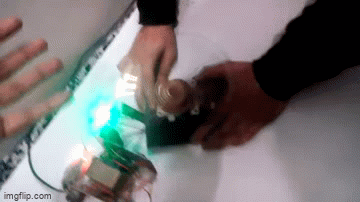
Perception of Vision (POV) Display
January – May 2017
Motivation: We (I, along with my teammates) were looking for a challenging project that had a good mix of hardware and software problems. So, we chose POV display.
Objective: To display “YMCA” on an array of LEDs mounted on a rotating PCB.
Details: We were a team of four who contributed to making this project under the guidance of our college professor.
Key Features and tools/ resources used
- Used self made kit instead of a ready-made one
- Atmega32A PDIP package as a micro controller
- Hall effect sensor as an interrupt sensor
- Series of LEDs mounted on a PCB
- DC motor for rotating the PCB
- power supply was provided with a self-made AC-DC conversion unit.
- Slip ring and brush assembly for power transfer to moving part
Everything was made from scratch on our own as we wanted to face the challenge on the hardware side as well. Motor power could have been provided easily with help of wires but we faced a challenge in providing power to PCB as it was a rotating unit. We did not use a battery to power PCB as we wanted to have more space for LEDs and micro-controller. Moreover, placing the battery was creating problems in the weight balancing of the circuit. So, we used slip ring and brush assembly for conducting electricity to the rotating PCB. IC LM7805 was used to regulate uC voltage and air cooling was naturally present in place (as the setup was rotating) to tackle the heat generated. We also used copper-enameled wire to connect LEDs with a micro-controller to reduce the weight of the overall PCB assembly. These were the hardware challenges that we faced.
On the software side, it required a lot of effort in programming the code as the timing after which LEDs need to be turned ON after interrupt was a crucial factor in its working. We adjusted timing multiple times so that the text that we intended to display on it was readable. Through many attempts, we were finally able to make this setup reliable and working. In the end, “YMCA” (our college name) was displayed on it.
We faced many mechanical and electronics challenges in making this project and learned how to tackle and solve them. It was also a test of our patience as we faced many failed attempts while making it.